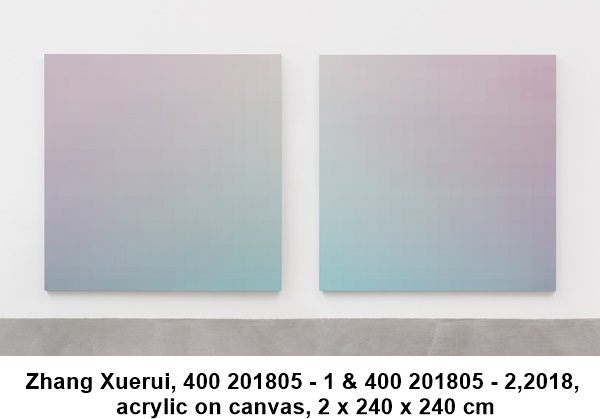"The Everyday as Ontology"
Zhang Xuerui

Galerie Urs Meile
Rosenberghöhe 4 6004 Lucerne, SwitzerlandT +41 (0)41 420 33 18 F +41 (0)41 420 21 69 e-mail:


6.6 > 17.8, 2019
 |
Galerie Urs Meile is pleased to announce The Everyday as Ontology, the first solo exhibition of Chinese artist Zhang Xuerui (*1979, lives and works in Beijing) at our Lucerne gallery. The exhibition will present Zhang Xuerui’s most recent paintings and her textile installations. Her paintings are often quick categorized as “abstract painting”. It seems like a simple task to understand her works. An experienced viewer could be able to discern her methodologies quickly, which is to strictly divide the canvas into an orderly grid, and to fill the units in that grid with gradually shifting colors. People often classify her works as part of one of the various art trends of Western contemporary art, such as post-painterly abstraction, hard edge abstraction, minimalism, however, it would be a too cursory decision. If abstraction in Western art has clear conceptual pursuits within the art history context, then in comparison, not only has “abstraction” not formed into a specific art history narrative in China, it is actually a style that stretches back into ancient times, from folk decorations to literati calligraphy and imperial ornamentation. In ancient Chinese tradition, “abstraction” is an established fact, an everyday aesthetic, and for that reason, there never arose a need for discourse, nor did there ever form a corresponding set of critical concepts.
For the artists of Zhang Xuerui’s generation, the visual resources of Western contemporary art have appeared before them in a fragmentary form. Abstraction is merely one of the many styles available to reference. In Zhang Xuerui’s case, she has her own special content and meaning behind her “abstraction.” She majored in architecture, which has to some extent influenced her precise grid style and sophisticated painting method: once she has begun to paint, she must continue until she finishes one row of the grid, as the adjoining colors in the gradient must be completed while the paint is still wet. Zhang Xuerui’s approach also encompasses a process of aestheticization of everyday time and the labor of the body; time and labor have been marked down in each single individual square of the grid to become subjects of self-reflection and contemplation. For her, the grid approach to painting also evokes the experience of practicing calligraphy using square guidelines. The structure of her paintings is just like the calligraphy practice books from her childhood, using squares as their fundamental units.
Zhang Xuerui often starts with three corners of the painting, deciding the colors of these three squares. Her next task is to then form a virtually undetectable transition between them. For this reason, by the time she begins the color gradient component, the tones or the order of the colors is no longer the most important task. This is especially the case when she focuses her attention within a single grid. Within this one isolated unit, the act of painting, and the control of the body’s movements, form an immersive experience. In addition, the highly compressed color contrasts of the neighboring squares focus our attention on the finest color perceptions, while our judgment of the whole is temporarily suspended, which is to say that the viewing of the painting has, just like the act of painting itself, entered into a linear (temporal) experience. In this sense, Zhang Xuerui’s painting touches on the sense of the everyday we all inhabit, magnifying a detail, or extending a moment, concentrating on a single shaft of bamboo while ignoring the forest around it.
One meaningful detail is that in a given period, the individual squares in her grids will all be virtually the same size, regardless of the dimensions of the canvas. In other words, the wholes of her artworks do not precede the parts. She does not predetermine such metaphysical concepts as wholeness or completeness, and metaphysical properties are usually typical markers of Western modernist abstraction. All of her chosen colors are compound colors, colors closer to the actual appearance of nature. In her most moving paintings, the gradient color fields present us with the colors of the sky, as if they are records of daylight over time, as well as a salute to a day’s labor in the studio, just as her artworks are named only by the time they were completed.
In analyzing and discussing Zhang Xuerui’s paintings, we should not overlook her textile works, which form a corresponding clue to her paintings. In these works, she often cuts out patterns on blankets or clothing—sometimes flowers, sometimes hearts, sometimes circles—then rearranges and affixes them together in a new layout that often resembles an abstract painting. These artworks more clearly reveal her close examination of everyday life experience: this items are often something once worn or used by herself or her family members which bear loads of her individual memories and experiences. For Zhang Xuerui, art is not the opposite of life, on-canvas art is not the opposite of off-canvas art, abstraction is not the opposite of representation, and contemporary is not the opposite of tradition. For this reason, we have no need to distinguish between her art and her life. When she has labored on her painting for a day, she has lived for a day. Life and art are both passing the days, with perceptible time as its ontology.
For the artists of Zhang Xuerui’s generation, the visual resources of Western contemporary art have appeared before them in a fragmentary form. Abstraction is merely one of the many styles available to reference. In Zhang Xuerui’s case, she has her own special content and meaning behind her “abstraction.” She majored in architecture, which has to some extent influenced her precise grid style and sophisticated painting method: once she has begun to paint, she must continue until she finishes one row of the grid, as the adjoining colors in the gradient must be completed while the paint is still wet. Zhang Xuerui’s approach also encompasses a process of aestheticization of everyday time and the labor of the body; time and labor have been marked down in each single individual square of the grid to become subjects of self-reflection and contemplation. For her, the grid approach to painting also evokes the experience of practicing calligraphy using square guidelines. The structure of her paintings is just like the calligraphy practice books from her childhood, using squares as their fundamental units.
Zhang Xuerui often starts with three corners of the painting, deciding the colors of these three squares. Her next task is to then form a virtually undetectable transition between them. For this reason, by the time she begins the color gradient component, the tones or the order of the colors is no longer the most important task. This is especially the case when she focuses her attention within a single grid. Within this one isolated unit, the act of painting, and the control of the body’s movements, form an immersive experience. In addition, the highly compressed color contrasts of the neighboring squares focus our attention on the finest color perceptions, while our judgment of the whole is temporarily suspended, which is to say that the viewing of the painting has, just like the act of painting itself, entered into a linear (temporal) experience. In this sense, Zhang Xuerui’s painting touches on the sense of the everyday we all inhabit, magnifying a detail, or extending a moment, concentrating on a single shaft of bamboo while ignoring the forest around it.
One meaningful detail is that in a given period, the individual squares in her grids will all be virtually the same size, regardless of the dimensions of the canvas. In other words, the wholes of her artworks do not precede the parts. She does not predetermine such metaphysical concepts as wholeness or completeness, and metaphysical properties are usually typical markers of Western modernist abstraction. All of her chosen colors are compound colors, colors closer to the actual appearance of nature. In her most moving paintings, the gradient color fields present us with the colors of the sky, as if they are records of daylight over time, as well as a salute to a day’s labor in the studio, just as her artworks are named only by the time they were completed.
In analyzing and discussing Zhang Xuerui’s paintings, we should not overlook her textile works, which form a corresponding clue to her paintings. In these works, she often cuts out patterns on blankets or clothing—sometimes flowers, sometimes hearts, sometimes circles—then rearranges and affixes them together in a new layout that often resembles an abstract painting. These artworks more clearly reveal her close examination of everyday life experience: this items are often something once worn or used by herself or her family members which bear loads of her individual memories and experiences. For Zhang Xuerui, art is not the opposite of life, on-canvas art is not the opposite of off-canvas art, abstraction is not the opposite of representation, and contemporary is not the opposite of tradition. For this reason, we have no need to distinguish between her art and her life. When she has labored on her painting for a day, she has lived for a day. Life and art are both passing the days, with perceptible time as its ontology.
 |
Zhang Xuerui |
OPENING :
Thursday, June 6, 2019, 5.30–7.30pm, the artist will be present.
mpefm
SWITZERLAND art press release
Opening hours :
Tuesday to Friday, 10am-6pm
Saturdays: Visitors welcome, please schedule an appointment
Saturdays: Visitors welcome, please schedule an appointment
QR of this press release
in your phone, tablet








